User:SONIC123CDMANIA+&K(B&ATSA)/Super Mario (franchise) Rewrite/Super Mario (series)/Super Mario (sub-series): Difference between revisions
From the Super Mario Wiki, the Mario encyclopedia
Jump to navigationJump to search
(1st revision.) |
|||
| Line 8: | Line 8: | ||
!width=15% style="background-color:#e0e0e0;"|Cover, original release, and system | !width=15% style="background-color:#e0e0e0;"|Cover, original release, and system | ||
!width=85% style="background-color:#e0e0e0;"|Synopsis | !width=85% style="background-color:#e0e0e0;"|Synopsis | ||
|- | |- | ||
!colspan="2"style="font-size:125%;text-align:left"|''[[Super Mario 64]]'' | !colspan="2"style="font-size:125%;text-align:left"|''[[Super Mario 64]]'' | ||
Revision as of 08:40, April 5, 2024
WIP
List of games
Main games
| Title | |
|---|---|
| Cover, original release, and system | Synopsis |
| Super Mario 64 | |
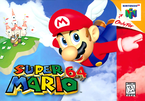 Nintendo 64 |
Super Mario 64 was released simultaneously with its system, the Nintendo 64. The game was a great success. It was the first fully three-dimensional Super Mario game to ever be made, thus revolutionizing the appearance of Super Mario games to date. The game sold over eleven million copies by 2007.[1] This was also the second game to call Princess Peach by her current name (with Yoshi's Safari being the first). In the game, Mario is invited to the Mushroom Castle to eat a cake she has baked. However, when Mario arrives at her castle, he discovers that Bowser has taken it over and has stolen almost all of the castle's Power Stars—there are some that he did not know existed. As Mario traverses through fifteen different painting worlds, he eventually recovers enough Power Stars to battle Bowser and take back the castle, freeing Peach from her stained-glass prison. |
| Super Mario Sunshine | |
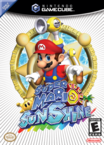 GameCube |
In 2002, Mario was back in action in Super Mario Sunshine, another three-dimensional platformer. While he is on his way to a vacation with Princess Peach and her loyal steward, Toadsworth, they discover a large glob of graffiti in the shape of Mario's head at the Delfino Airstrip. Mario then finds a machine, called FLUDD, that helps him rid the island of goop. After he collects a total of ten Shine Sprites, an impostor bearing a striking resemblance to Mario kidnaps Peach. Mario then must redeem his identity (because of Shadow Mario) by ridding the entire island of goop, all the while having to rescue Peach. Towards the end of his adventure, he discovers that Shadow Mario is actually Bowser Jr. in disguise. After fighting Bowser and Bowser Jr., Mario rescues Peach, finally allowing them to start their vacation. |
| New Super Mario Bros. | |
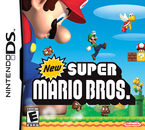 Nintendo DS |
New Super Mario Bros. is the tenth installment in the Super Mario series. It starts out when Bowser Jr. kidnaps Peach during a strange accident. Luigi is playable in this game as well. Luigi was not playable since Super Mario World. This is the first game since Super Mario World that features the classic 2D playstyle of the Super Mario Bros. games, substantially building upon it to create gameplay both classic and contemporary. The game features a solo story mode with Mario or Luigi, a two-player wireless game called Mario vs. Luigi, and a minigame mode for up to four players. It introduced various enemies and obstacles to the franchise alongside new power-ups: the Mega Mushroom, Mini Mushroom, and Blue Shell. It was released in 2006 for the Nintendo DS. It spiraled an indirect follow-up, New Super Mario Bros. Wii, and, later, a direct sequel, New Super Mario Bros. 2, alongside another indirect follow-up, New Super Mario Bros. U. |
| Super Mario Galaxy | |
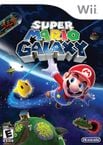 Wii |
Super Mario Galaxy is the eleventh installment in the Super Mario series and the third 3D game in the series. However, unlike the previous two 3D installments for the Super Mario series, this game takes place in deep space. Mario attends the Star Festival at the request of Princess Peach, when the town comes under attack by Bowser's air forces. He abducts Peach's entire castle and warps it to the center of the universe, prompting Mario to save her. Most of the game's levels consist of many small planets and planetoids, while others have bigger planets. A new popular species and character appear, Luma and Rosalina. The game was released in 2007 for the Wii. This game spiraled a direct sequel, simply called Super Mario Galaxy 2. It is currently the only 3D game that has done so. |
| New Super Mario Bros. Wii | |
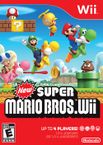 Wii |
Being the indirect follow-up to New Super Mario Bros. for the DS, New Super Mario Bros. Wii was released on November 12, 2009, in Australia. This installment includes four players simultaneously controlling their characters, a feature Shigeru Miyamoto had wanted for years. This game also returns the Koopalings, absent since Mario and Luigi: Superstar Saga, in their first 3D models. In the story, Bowser and his minions kidnap Peach by using cake as a disguise. Mario, Luigi, Blue Toad, and Yellow Toad travel to eight worlds to save the princess. This game also reintroduces rideable Yoshis, although they can be ridden in only a few levels. The Penguin Suit and the Propeller Mushroom are new power-ups in this game. This game also includes the Super Guide, a demo video for those who are struggling in a particular level. |
| Super Mario Galaxy 2 | |
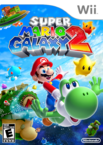 Wii |
Super Mario Galaxy 2 is the thirteenth installment in the Super Mario series. It is also the fourth 3D game in the series and a direct sequel to Super Mario Galaxy. The title contains many elements from its predecessor, such as the story, the adventure being in outer space, recurring objects such as Launch Stars, recurring items including the Bee Mushroom, and the elements of gravity. However, the game introduces new elements such as the utilization of Yoshi and new power-ups such as the Cloud Flower. Rosalina reappears, and new characters of the Luma species appear, including Lubba. This is the third installment for the Wii in the Super Mario series. |
| Super Mario 3D Land | |
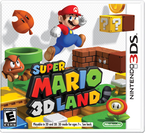 Nintendo 3DS |
Super Mario 3D Land is the fifth 3D game in the series and the fourteenth game overall. Super Mario 3D Land is a hybrid game described as a "3D game that plays like a 2D game," and therefore its levels are much more linear and compact than in the other 3D titles, more along the lines of the side-scrolling games. Many retro power-ups and characters return, such as the Super Leaf and Boom Boom. New power-ups are also introduced, such as Boomerang Mario and White Tanooki Mario. The game also introduces new enemies and a female partner of Boom Boom named Pom Pom. |
| New Super Mario Bros. 2 | |
 Nintendo 3DS |
New Super Mario Bros. 2 is another side-scroller in the series released in 2012 for the Nintendo 3DS. It is the third game in the New Super Mario Bros. line and a direct sequel to New Super Mario Bros. The game features an extremely large number of coins, which are the game's main focus, with the primary goal being to collect one million. The game also notably is very similar to New Super Mario Bros. Wii, reusing various things from it, while also featuring several elements from Super Mario Bros. 3, such as Raccoon Mario. A new power-up called the Gold Flower appears and turns Mario into Gold Mario. |
| New Super Mario Bros. U | |
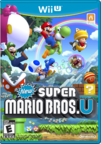 Wii U |
New Super Mario Bros. U is a side-scroller released for the Wii U alongside the console's launch. The game features some elements from Super Mario World, such as an interconnected world map, Baby Yoshis, Sumo Bros., and Bony Beetles, and minor references such as diagonal pipes making a return. The game plays very similarly to New Super Mario Bros. Wii with its four-player mode—however, a player with a Wii U GamePad can create platforms in what Nintendo refers to as "Boost Mode." Additionally, the game also features single-player Challenges. It is the first Super Mario game to be released in high-definition. The game also introduces the Super Acorn power-up, with which Mario can become Flying Squirrel Mario. |
| Super Mario 3D World | |
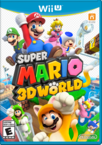 Wii U |
Super Mario 3D World is the home console follow-up to Super Mario 3D Land. The game's main feature is the new Cat form, caused by picking up a Super Bell, alongside four-player simultaneous multiplayer. It features the entire playable cast of Super Mario Bros. 2 as playable characters, featuring the same abilities they have in said game, as well as Rosalina as an unlockable playable character. The story follows Mario, Luigi, Princess Peach, and Toad as they attempt to rescue the Sprixie Princesses that Bowser has captured and free the Sprixie Kingdom. Other new power-ups include the Double Cherry and the Lucky Bell. |
| Super Mario Maker | |
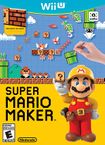 Wii U |
Super Mario Maker features a game creation system that allows players to create their own 2D Super Mario levels. Players can choose between four different styles based on Super Mario Bros., Super Mario Bros. 3, Super Mario World, and New Super Mario Bros. U for their levels, each adapting certain mechanics and power-ups exclusive to the original games. Level creations could be submitted to the internet so players could share their levels worldwide. Super Mario Maker was released on time for the series' 30th anniversary. |
| Super Mario Run | |
 December 15, 2016 iOS |
Super Mario Run is an auto-runner platform game and the first dedicated Super Mario title for mobile devices. It was released first on iOS in December 2016, and it was released for Android in March 2017. The game is free-to-start, with optional in-app content to purchase at a one-time fee. Its gameplay is similar to that of the New Super Mario Bros. sub-series but with a different control style. Like Super Mario 3D World, it features the cast of Super Mario Bros. 2 as playable characters, alongside Yoshi, Toadette, and Princess Daisy, who all make their first fully playable appearances in a 2D Super Mario game. |
| Super Mario Odyssey | |
 October 27, 2017 Nintendo Switch |
Super Mario Odyssey released for the Nintendo Switch in late 2017. As a new entry in the 3D games and a new sandbox-style 3D Super Mario game after Super Mario 64 and Super Mario Sunshine, it focuses on Mario and a new character named Cappy (who takes the form of the Mario Cap) visiting kingdoms far from the Mushroom Kingdom and collecting Power Moons, ultimately in an attempt to prevent Bowser force-marrying Princess Peach and to rescue Cappy's sister Tiara. Cappy has multiple uses, such as being thrown like a boomerang (which can be used to control life forms and inanimate objects) and jumping off him in midair like a platform. In addition, this is the first main Super Mario game to be compatible with amiibo, and it was launched alongside a trio of amiibo based on the game. |
| Super Mario Maker 2 | |
 June 28, 2019 Nintendo Switch |
Super Mario Maker 2 is the sequel to the Wii U title Super Mario Maker. This sequel introduces many new additions and improvements, such as slopes, more level themes, and a Super Mario 3D World style. |
| Super Mario Bros. Wonder | |
 October 20, 2023 Nintendo Switch |
Super Mario Bros. Wonder is a side-scroller for the Nintendo Switch. Its plot involves Mario and his allies setting out to save the Flower Kingdom from Bowser. The game plays similarly to the New Super Mario Bros. sub-series with its four-player mode. The game's central mechanic is Wonder Effects, which are triggered by collecting Wonder Flowers. Collecting them in different levels causes various different effects. It also introduces three new power-ups: the Elephant Fruit, Bubble Flower, and Drill Mushroom, which transform characters into their Elephant forms, Bubble forms, and Drill forms, respectively. This is also the first game to feature Kevin Afghani succeeding Charles Martinet in voicing Mario and Luigi. |
Related games
These original games are related to the Super Mario series while not being considered part of it by official Nintendo websites. Many of them feature the adventures of characters other than Mario, sometimes leading into their own series. Notably, Shigeru Miyamoto stated that he considered Super Mario World 2: Yoshi's Island to be part of the core Super Mario franchise in an interview published in 2012.[2]
| Title | |
|---|---|
| Cover, original release, and system | Synopsis |
| Super Mario Bros. Special | |
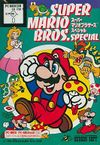 NEC PC-8801, Sharp X1 |
Super Mario Bros. Special is a game made by Hudson Soft and licensed by Nintendo for the NEC PC-8801 and Sharp X1 series of Japanese PCs, and later released in South Korea for the Samsung SPC-1500 in 1987. Super Mario Bros. Special is the second sequel to Super Mario Bros., released a few months after Super Mario Bros.: The Lost Levels in 1986. While superficially very similar to the original Super Mario Bros., the game features original levels but scrolls screen-by-screen rather than smoothly. Jumping and running physics also differ from the original, providing a more challenging experience than Super Mario Bros. Due to the computers' technology being slightly inferior to that of the NES/Famicom, the graphics and audio differ from the original NES game as well, with the X1 utilising more colors and smoother scrolling than the PC-88, and does not include Luigi or a multiplayer mode. |
| Yume Kōjō: Doki Doki Panic | |
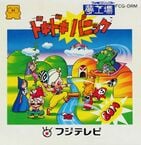 Family Computer Disk System |
Yume Kōjō: Doki Doki Panic started development as a vertically scrolling Super Mario Bros.-style game, eventually gaining horizontal scrolling as well to be more similar. Due to a licensing agreement with Fuji Television, it starred a family of Arabian characters owned by the network. This game would go on to become the western Super Mario Bros. 2, with the Arabian characters replaced with Mario and friends, though other characters (namely enemies and bosses) remaining; many would become recurring to the series. |
| Wario Land: Super Mario Land 3 | |
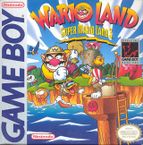 Game Boy |
Wario Land: Super Mario Land 3 is the third and final original Super Mario Land title and the first installment in the Wario Land series, released in 1994, five years after its first predecessor and two years after its second predecessor. Taking place after his defeat in Super Mario Land 2: 6 Golden Coins, Wario decides to go on a quest to earn himself enough money and riches to get himself a castle of his own. During his quest, he finds many treasures as he battles Captain Syrup and her army, the Black Sugar Gang. The gameplay in Wario Land differs slightly from the previous Super Mario Land installments. For example, if the player holds down the B button, then Wario does not run. His speed does increase, however, if Wario is using the Jet Wario power-up, which allows him to temporarily fly through the air at super speed. His other power-ups include Bull Wario, which gives him super strength and the ability to stick to ceilings and conveyor belts, and the Dragon Wario power-up, which allows him to breathe fire. Wario is also able to hold and throw enemies (as well as coins, which are usually required to exit a stage). |
| Super Mario World 2: Yoshi's Island | |
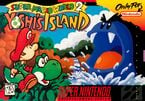 SNES |
While the title suggests it being a sequel to Super Mario World, Super Mario World 2: Yoshi's Island is in fact the prequel not only to the Super Mario series but the chronological first game of the whole Super Mario franchise. The game starts off on the day the Mario Bros. were born and are to be delivered to their parents by a dedicated stork. Foretelling the threat they will represent to the Koopa clan in the future, Kamek tries to kidnap the babies from the stork but only manages to snatch one baby (Baby Luigi) and imprisons the stork as well. The other baby (Baby Mario) falls on Yoshi's Island where he is picked by the Yoshis that reside in there. The Yoshis come to the decision to aid the baby to rescue his brother and the stork from the Koopa clan led by the young Baby Bowser. |
| New Super Luigi U | |
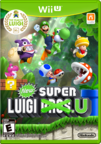 Wii U |
New Super Luigi U is an additional content pack for New Super Mario Bros. U that was also released as a stand-alone game to celebrate the Year of Luigi, available at retail until the end of the 2013. It has all-new levels and Luigi supplants Mario as the lead character, with Nabbit becoming the fourth playable character, taking Mario's place. |
| Captain Toad: Treasure Tracker | |
Wii U |
Captain Toad: Treasure Tracker is a puzzle-platform game, a spin-off and prequel of Super Mario 3D World based on Captain Toad's Adventures stages from the latter but featuring extensive depth and variety. The game also features Toadette as a new playable character, but also takes the role of damsel-in-distress. A port was released on July 13, 2018 for the Nintendo Switch and Nintendo 3DS, which replaces the bonus stages based on Super Mario 3D World with stages based on kingdoms from Super Mario Odyssey. |
| Super Mario Bros. 35 | |
 October 1, 2020 Nintendo Switch |
Super Mario Bros. 35 was a side-scrolling, battle royale platform game where 35 players competed against each other until one player remained standing. |
Ports, remakes, and compilations
| Title | |
|---|---|
| Cover, original release, and system | Synopsis |
| VS. Super Mario Bros. | |
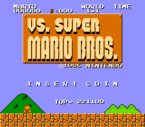 VS. System |
VS. Super Mario Bros. is a two-player arcade game released in North America in 1986. The game is mostly the same as the original Super Mario Bros.; Mario or Luigi went on a quest to save the princess from Bowser and restore order to the Mushroom Kingdom. The game is made harder than Super Mario Bros. in that it had fewer warp zones and more enemies, along with options for the arcade owner to make it more difficult still and thus restrict the time an average player got for their money. The game replaced "duplicate" levels from the original with levels which would later be used in the Japanese Super Mario Bros.: The Lost Levels. |
| Super Mario Bros. (Game & Watch) | |
 Game & Watch |
In 1986, one year after the release of Nintendo's first biggest commercial success, the company released a simplified version of the game on their Game & Watch system. It essentially has the same plot, reduced down to only eight levels; however, after beating every level, they will have to be repeated. Mario will have to go through nine loops, avoiding Lakitus and Bullet Bills, each time with the levels increasing in difficulty. There are also two types of levels: scroll screen levels, in which Mario will have to reach a certain point to advance, and timer screen levels, in which Mario must get through the world in a given amount of time. Additionally, another difference between the original and this remake is that Mario will find Princess Toadstool at the end of every level, without having to fight a boss. |
| All Night Nippon: Super Mario Bros. | |
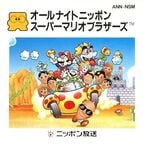 Disk System |
All Night Nippon: Super Mario Bros. is an officially licensed hack of Super Mario Bros.: The Lost Levels. Gameplay is the same, but many characters such as the mushroom retainers are replaced with Japanese celebrities from the radio show All Night Nippon. Other changes are also made for this game, such as World 1 being set during nighttime and Princess Peach's outfit was changed. The game was only released in Japan. |
| Super Mario Bros. (Nelsonic Game Watch) | |
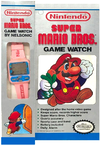 Nelsonic Game Watch |
Super Mario Bros. is a simplified version of the original game released on the Nelsonic Game Watch. The instruction leaflets for these watches contain many spelling errors and inconsistent terminology. Mario has to struggle up a castle to rescue the princess and defeat the Koopa Dragon. |
| Super Mario Bros. 3 (Nelsonic Game Watch) | |
 Nelsonic Game Watch |
Super Mario Bros. 3 is a direct sequel to the previous watch and a tie-in product to the North American release of the original game. It is also known as Super Mario 3 and Super Mario III. This installment contains the Super Leaf, which transforms Mario into long tail Mario. |
| Super Mario World (Nelsonic Game Watch) | |
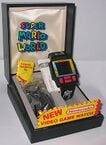 Nelsonic Game Watch |
The Super Mario World game watch is also a tie-in product for the North American release of the original game. This sequel is also known as Super Mario Bros. 4 and Super Mario 4. Mario rides a dinosaur to rescue the princess from Koopa. |
| Super Mario All-Stars | |
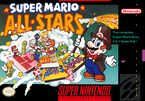 SNES |
Super Mario All-Stars, known as Super Mario Collection in Japan, was released in 1993 also for the Super Nintendo Entertainment System. It is a compilation featuring 16-bit versions of the first four main Super Mario series games: Super Mario Bros., Super Mario Bros. 2, Super Mario Bros. 3 and, in its first release outside of Japan, Super Mario Bros.: The Lost Levels. This game updated the four games' graphics and sound to enhance them, with certain changes to the mechanics. A Wii rerelease, called Super Mario All-Stars Limited Edition, occurred in 2010. |
| Super Mario All-Stars + Super Mario World | |
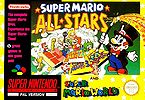 SNES |
Super Mario All-Stars + Super Mario World is an America/Europe-only reissue of Super Mario All-Stars that also includes Super Mario World for the Super Nintendo Entertainment System. |
| BS Super Mario USA | |
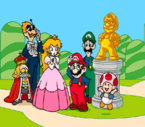 Satellaview |
A follow-up to Super Mario USA (Super Mario Bros. 2), BS Super Mario USA was released as four installments, and each one involved the player heading into each world to collect a gold Mario statue and defeat the bosses until finally reaching and defeating Wart. Each level could be replayed until the clock reached 50 minutes. As the player progressed, St. Giga's Satellite radio would stream an audio drama to tell the story. After the events of Super Mario Bros. 2, the King of Subcon had golden Mario statues put up all around Subcon, to thank him and his friends for their deeds. However, three Birdos, Mouser, Tryclyde, Fryguy and Clawgrip have stolen them, and now Mario must get them back and defeat Wart again. |
| BS Super Mario Collection | |
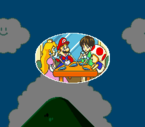 Satellaview |
A remake of Super Mario Collection (Super Mario All-Stars), BS Super Mario Collection is a game for the Super Famicom add-on Satellaview. Like with BS Super Mario USA, as the player progressed through the game, voice acting and music would be streamed to the system using the Satellaview's Soundlink capabilities. |
| Super Mario Bros. Deluxe | |
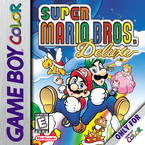 Game Boy Color |
Super Mario Bros. Deluxe is a Game Boy Color remake which includes the first two Super Mario games ever released: Super Mario Bros. and Super Mario Bros.: The Lost Levels (that last under the name of Super Mario Bros. for Super Players). Besides those games, it also featured many other collectibles, including images that could be printed with the Game Boy Printer, Cable Link interface multi-player, records sharing by infrared connection, a calendar, a fortune teller, etc. Unlike other remakes, it was not developed by Nintendo EAD, but rather by Nintendo R&D2. |
| Super Mario Advance | |
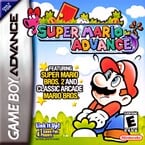 Game Boy Advance |
Super Mario Advance is a remake of Super Mario Bros. 2 made for the handheld game system, the Game Boy Advance, and released in 2001. Like the Super Mario All-Stars remake, Super Mario Advance had updated graphics, alongside various gameplay additions and improvements such as a points scoring system and collectable Ace Coins. Additionally, Mario Bros. is included with the game. It spawned a series of similar remakes, all featuring Mario Bros. as well. |
| Super Mario World: Super Mario Advance 2 | |
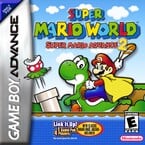 Game Boy Advance |
Super Mario World: Super Mario Advance 2 is a remake of Super Mario World made for the Game Boy Advance. It is the second title in the Super Mario Advance series and was released in 2002. There are various differences between the original Super Mario World and Super Mario Advance 2 such as Luigi's sprite being changed and made taller than Mario to match his normal appearance. The game was a gigantic hit for Nintendo and the Game Boy Advance, selling 3,290,000 copies in North America and 5,460,000 copies worldwide. |
| Yoshi's Island: Super Mario Advance 3 | |
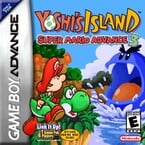 Game Boy Advance |
Yoshi's Island: Super Mario Advance 3 is a remake of Super Mario World 2: Yoshi's Island for the Game Boy Advance. The game features similar visuals to the original game, though due to the lack of the Super FX chip, the game tracks behind some graphical aspects. Super Mario Advance 3 has six new levels and Yoshi's Story voice acting and sound effects. |
| Super Mario Advance 4: Super Mario Bros. 3 | |
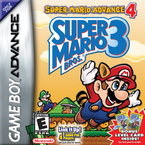 Game Boy Advance |
In 2003, the fourth (and final) Super Mario Advance installment, Super Mario Advance 4: Super Mario Bros. 3, was released for the Game Boy Advance. It boasted similar graphics and sound to the Super Mario All-Stars version of Super Mario Bros. 3, and made use of the e-Reader. A few e-Reader cards came included with new copies of the game, while two sets (referred to as "series") of cards, were released and sold alongside the game. By scanning special cards into the e-Reader, players were able to upload items, videos, and most importantly, new levels into the game. One notable item was the Cape Feather from Super Mario World, which allowed Mario to transform into Caped Mario. There were also two Switch cards that the player could activate (and deactivate) the effects of by scanning them; the Orange Switch and the Blue Green Switch. Scanning these switches triggered small functions in the game. The e-Reader feature is still coded in the European version, but is disabled by default. The Virtual Console and Game Boy Advance - Nintendo Switch Online versions would feature all e-Reader levels and features unlocked by default for all regions. |
| Classic NES Series: Super Mario Bros. | |
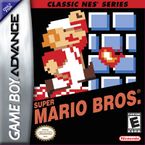 Game Boy Advance |
The original NES version of Super Mario Bros. was released for the Game Boy Advance as part of the Classic NES series of games in commemoration for the 20th anniversary of the release of the original Famicom and NES. It is a direct port, and as a result features no new additions or bugfixes. Consequently, the only significant difference is that the graphics were downscaled to fit the GBA screen resolution. |
| Famicom Mini: Super Mario Bros. 2 | |
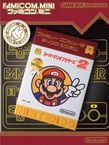 Game Boy Advance |
In Japan, the Classic NES Series were known as Famicom Mini. The original Super Mario Bros. 2 (or Super Mario Bros.: The Lost Levels) was released only in Japan. Much like Super Mario Bros., it didn't feature any new additions, the bugs were left untouched, and the graphics were down-scaled. |
| Super Mario 64 DS | |
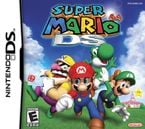 Nintendo DS |
Super Mario 64 DS is a remake of Super Mario 64. It was released in 2004 for the Nintendo DS. It is also the first Mario game released for the Nintendo DS. Though it is a remake, there are many differences between it and the original (four playable characters and 30 new Power Stars are two examples of this). The game begins the same as the old one; Peach invites Mario to the castle for cake. However, instead of just Mario, Wario and Luigi come for cake, while Yoshi sleeps on the roof of the castle. Bowser then takes over the castle, captures Peach, and locks Mario, Luigi, and Wario inside three rooms. Lakitu then wakes Yoshi up, and now he has to save Mario and the others in order to save the princess once again, this time through teamwork. |
| Super Mario All-Stars Limited Edition | |
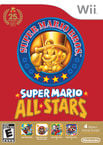 Wii |
Released for the Wii in 2010, Super Mario All-Stars Limited Edition is a port of Super Mario All-Stars that celebrates the 25th anniversary of Mario. |
| New Super Mario Bros. U + New Super Luigi U | |
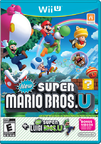 Wii U |
A compilation of both New Super Mario Bros. U and New Super Luigi U on the same disc, initially released exclusively with the Mario & Luigi Deluxe Wii U set (known as the Premium Pack in Europe). New Super Mario Bros. U + New Super Luigi U includes notable changes to the originals, including a new title screen and over 200 videos included as bonus content. This compilation was released separately as a Nintendo Selects title in 2016. |
| Super Mario Maker for Nintendo 3DS | |
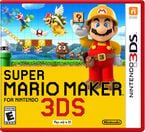 Nintendo 3DS |
A port of Wii U's Super Mario Maker released in 2015, Super Mario Maker for Nintendo 3DS was released on December 2, 2016. Despite being a Nintendo 3DS title, the game does not support stereoscopic 3D, and gameplay is, therefore, strictly available in 2D. Due to hardware limitations for the 3DS, players can no longer share their levels online, and other elements from the Wii U version, like the Mystery Mushrooms and amiibo compatibility, have been removed. The game features Super Mario Challenge, a single player mode with 100 pre-installed courses designed by Nintendo, with medal objectives included for each course. |
| New Super Mario Bros. U Deluxe | |
 January 11, 2019 Nintendo Switch |
New Super Mario Bros. U Deluxe is a combined port of the Wii U games New Super Mario Bros. U and New Super Luigi U, enhanced with exclusive features. Notably, this port is described as part of the main series for the Super Mario Bros. 35th Anniversary and in the Mario history section of Nintendo's website.[3] |
| Super Mario 3D All-Stars | |
 September 18, 2020 Nintendo Switch |
Super Mario 3D All-Stars is a rerelease of Super Mario 64, Super Mario Sunshine, and Super Mario Galaxy with revamped controls, HD resolution, and a music player that released as part of the 35th anniversary of Super Mario Bros. |
| Game & Watch: Super Mario Bros. | |
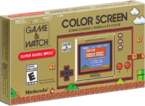 November 13, 2020 |
Unlike the Super Mario Bros. Game & Watch game released in 1987, Game & Watch: Super Mario Bros. is a direct port of Super Mario Bros. and Super Mario Bros.: The Lost Levels fit into a Game & Watch system with full-color screen display. The system also features a Super Mario-themed version of Ball. |
| Super Mario 3D World + Bowser's Fury | |
 February 12, 2021 Nintendo Switch |
Super Mario 3D World + Bowser's Fury is a port of the Wii U game Super Mario 3D World that released for Nintendo Switch in 2021. It contains new features, such as quicker movement speed, higher resolution, and amiibo compatibility. The game also has a new Bowser's Fury mode, in which Mario and Bowser Jr. aim to save Lake Lapcat from Fury Bowser. Like New Super Mario Bros. U Deluxe, the port is described as part of the main series in the Mario history section of Nintendo's website.[3] |
Canceled
| Title | |
|---|---|
| Screenshot and system | Synopsis |
| Super Mario's Wacky Worlds | |
 Philips CD-i |
Super Mario's Wacky Worlds is a canceled Philips CD-i game developed by NovaLogic. It was intended to follow-up on Super Mario World after a Nintendo sales executive suggested that the CD-i could play simple Nintendo games,[4] which is a result of Philips acquiring the rights to several Nintendo characters for use on their platform. The game was to feature a game world mostly based on real-life Earth locations, with themed old and new enemies in the Super Mario World sprite style. Despite NovaLogic impressing Nintendo with their work-in-progress, it was canceled due to poor sales of the CD-i.[4] |
| VB Mario Land | |
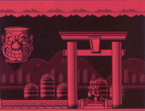 Virtual Boy |
VB Mario Land, also known as Mario Adventure[5], is a canceled Virtual Boy game which was revealed at the Winter Consumer Electronics Show in early 1995.[6] A Wario-like object can be seen in one of the released screenshots, so it is thought to be an unproduced follow-up to Super Mario Land 2: 6 Golden Coins. The game was to use two-dimensional side-scrolling elements, as well as the use of three-dimensional movement between the background and foreground of the stage. Its three-dimensional Mario Bros.-style mini-game was repurposed as Mario Clash.[7] |
| Super Mario 64 2 | |
 Nintendo 64DD |
Super Mario 64 2, the direct sequel to Super Mario 64, is a canceled Nintendo 64DD game. Luigi[8] and a rideable Yoshi[9] were set to appear, which were ideas unused during the creation of the original game.[10] Shigeru Miyamoto has stated in 1999 that the game's actual development only got as far as a two player demo level featuring Mario and Luigi.[11] An unreleased port of Super Mario 64 to the 64DD demoed at Space World 1996, known as Super Mario 64 Disk Version, may be related.[12] |
- ^ Super Mario 64 sales results
- ^ Interview with Shigeru Miyamoto, taken from Game Informer, issue 234. (Retrieved September 5, 2016)
- ^ a b Cite error: Invalid
<ref>tag; no text was provided for refs namedHistory - ^ a b Statement by Silas Warner - Programmer on Super Mario's Wacky Worlds
- ^ Big N magazine (Germany), July-August 2000, pg. 19
- ^ Nintendo Power issue #70, March 1995, pg. 29
- ^ Official Nintendo Magazine (Great Britain) January 2010, pg. 62
- ^ Info on Luigi's appearance
- ^ Owsen, Dan (January 1998). Nintendo Power volume 104, "Insider Collector's Edition". Page 16
- ^ "Super Mario 64 – 1996 Developer Interviews originally featured in the official strategy guides" shmuplations.com. Retrieved September 10, 2018.
- ^ Multiplayer information
- ^ https://gamingafterhours.com/2014/06/24/super-mario-64dd-version-discovered-in-japan/